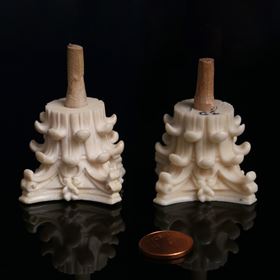 Identical parts made of ivory (left) and the new ivory substitute 'Digory' (right). Photo: TU Wien.
Identical parts made of ivory (left) and the new ivory substitute 'Digory' (right). Photo: TU Wien.For centuries, ivory was used to make art objects. But to protect elephant populations, the ivory trade was banned internationally in 1989. This means restoring ivory parts in old art objects has required substitute materials – such as bones, shells or plastic – but up to now there has never been a really satisfactory substitute.
Researchers at Vienna University of Technology (TU Wien) in Austria and the 3D printing company Cubicure GmbH, created as a spin-off from TU Wien, in collaboration with the Archdiocese of Vienna's Department for the Care of Art and Monuments and Addison Restoration, have now developed a high-tech substitute for ivory. They report their work in a paper in Applied Materials Today.
The novel material, called 'Digory', consists of synthetic resin and calcium phosphate particles, which are processed in a hot, liquid state and hardened in a 3D printer with UV rays to produce the desired shape. The material can then be polished and color-matched to create a deceptively authentic-looking ivory substitute.
"The research project began with a valuable 17th-century state casket in the parish church of Mauerbach," says Jürgen Stampfl from the Institute of Materials Science and Technology at TU Wien. "It is decorated with small ivory ornaments, some of which have been lost over time. The question was whether they could be replaced with 3D printing technology."
The team already had experience developing similar materials, such as ceramic materials for dental technology. Nevertheless, it was a challenging task to develop a suitable substitute for ivory.
"We had to fulfil a whole range of requirements at the same time," says Thaddäa Rath from TU Wien, who worked on the project as part of her dissertation. "The material should not only look like ivory, the strength and stiffness must also be right, and the material should be machinable."
Through numerous experiments, Rath and other members of the team from TU Wien and Cubicure eventually came up with an effective substitute. This comprised tiny calcium phosphate particles with an average diameter of about 7μm embedded in a special resin, together with extremely fine silicon oxide powder. The mixture is then processed at high heat in Cubicure's 3D printers using the hot lithography process, in which the material is cured with a UV laser, layer by layer, until the complete object is finished.
"You also have to bear in mind that ivory is translucent," explains Rath. "Only if you use the right amount of calcium phosphate will the material have the same translucent properties as ivory." Afterwards, the color of the object can be touched up – the team achieved good results with black tea. The characteristic dark lines that normally run through ivory can also be applied afterwards with high precision.
In the field of restoration, this is a big step forward. Not only is 'Digory' a major improvement on previous ivory substitutes, but 3D printing technology also makes it possible to reproduce the finest details automatically. Instead of painstakingly carving them out of the ivory substitute material, objects can now be printed in a matter of hours.
"With our specially developed 3D printing systems, we process different material formulations for completely different areas of application, but this project was also something new for us," says Konstanze Seidler from Cubicure. "In any case, it is further proof of how diverse the possible applications of stereolithography are."
The team hopes that 'Digory' will become generally accepted in the future – as an aesthetically and mechanically high-quality ivory substitute, for which no elephant has to lose a tusk.
This story is adapted from material from TU Wien, with editorial changes made by Materials Today. The views expressed in this article do not necessarily represent those of Elsevier. Link to original source.